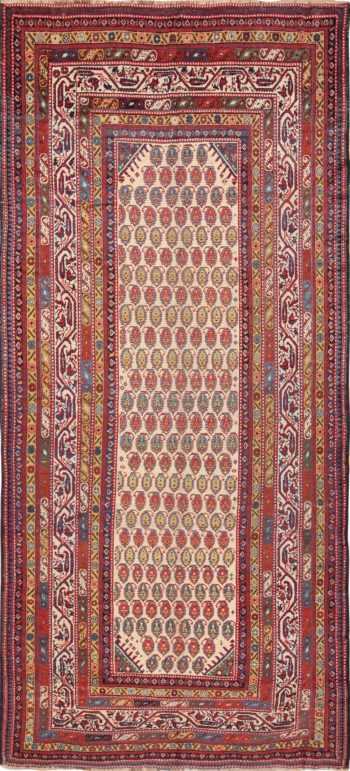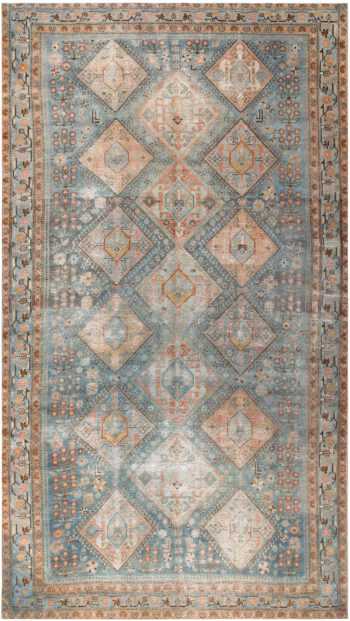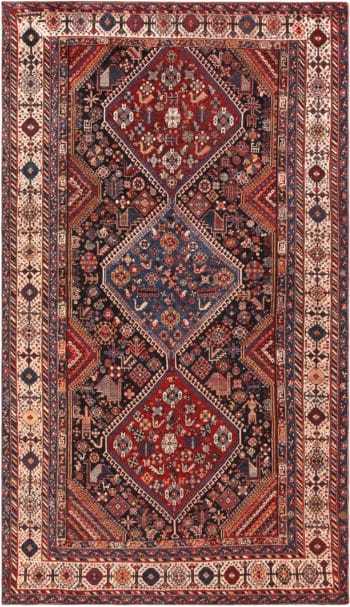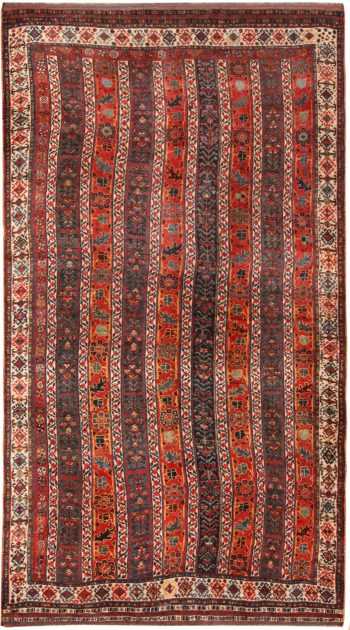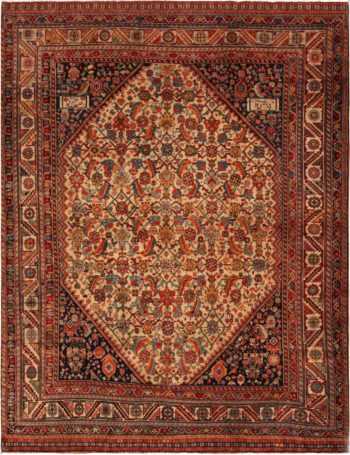Gashgai Qashqai Antique Rugs From Persia
Witness The Distinctive Allure Of Antique Persian Qashqai Rugs
View our current selection of antique Persian tribal Qashqai rugs below:
Beautiful Large Antique Tribal Geometric Persian Qashqai Gallery Rug 72144
$36,500.00Size: 9 ft 7 in x 16 ft 2 in (2.92 m x 4.93 m)Signed Tribal Antique Persian Jewel Tone Color Wool Pile Qashqai Hallway Runner Rug 71098
$9,600.00Size: 4 ft 1 in x 14 ft 3 in (1.24 m x 4.34 m)Wide Hallway Antique Tribal Persian Qashqai Runner Rug 49425
$14,500.00Size: 6 ft 3 in x 13 ft 6 in (1.9 m x 4.11 m)Allover Tribal Antique Persian Qashqai Long And Narrow Hallway Runner Jewel Tone Rug 71957
$11,500.00Size: 3 ft 5 in x 12 ft 9 in (1.04 m x 3.89 m)Beautiful Rustic Tribal Antique Persian Qashqai Shabby Chic Rug 72088
$16,500.00Size: 6 ft 7 in x 11 ft 8 in (2.01 m x 3.56 m)Rustic Tribal Antique Persian Qashqai Bird Rug 72184
$9,500.00Size: 5 ft 10 in x 10 ft 4 in (1.78 m x 3.15 m)Tribal Rustic Antique Casual Elegant Persian Qashqai Rug 71995
$9,500.00Size: 5 ft 1 in x 9 ft 3 in (1.55 m x 2.82 m)Rare Antique Persian Qashqai Horse Cover 47879
$12,500.00Size: 5 ft x 5 ft 7 in (1.52 m x 1.7 m)Antique Persian Silk Foundations Qashqai Signed Rug 71805
Size: 4 ft 4 in x 5 ft 6 in (1.32 m x 1.68 m)
Learn More About Tribal Antique Persian Qashqai Rugs
Antique Persian Qashqai rugs (sometimes spelled Ghashghai, Kashgai, or other variations) are beautiful and intricate, Tribal pile rugs. They get their name from Persian nomadic tribes that have lived in what is now southwest Iran for centuries. The Qashqai people lived in central Asia and the Caucasus region for many centuries before moving to their current home region. Because of this diverse history, influences from many regions are apparent in their carpets. Discerning viewers may recognize similarities to the artistic styles of the Turkmen people, Caucasians, and other tribes that live near them today.
Antique Qashqai rugs will typically feature dark reds, saffron golds, and rich blues. These colorful jewel tone rug colors were available to the ancient tribes with vegetable-based dyes, and today they are still often incorporated into the design despite the availability of a wider range of dyes. This is both a tribute to their past and a sign that Qashqai weavers refuse to sacrifice quality for easy-to-use synthetic dyes. Traditionally, the Qashqai tribes wove the designs into the antique rugs from memory, without the help of a pattern to copy.
Many Persian Qashqai rugs also used to feature multiple borders, since this allows the weaver to incorporate even more colors and designs. Some of these Persian rugs feature tassels or fringes along the short ends, though this is not a requirement.
Designs in the fields of these rugs feature many different images. Medallions, geometric shapes, and abstract patterns are common, but so are recognizable objects. The Qashqai people did not write down their history or stories, but would often weave them into their rugs. The antique Persian Qashqai rugs are said to tell tales and record their daily lives. They frequently depict people and animals, but also common household objects, including combs, trees, flowers, and possessions.
These Persian tribal rugs are created on vertical looms by making thousands of knots. The quality of a rug can be judged, in part, based on the density of the knots used to weave the carpet. The nomadic lifestyle of the Qashqai tribe meant that they required durable and good-quality rugs. This is why authentic antique Persian Qashqai rugs are made from hard-wearing wool and cotton. Although they are soft to the touch, these rugs do not feature a deep, overly thick pile. This is one reason why the Persian Qashqai rugs are highly sought after by modern home-owners who want durable rugs for high-traffic areas.
Today, it is possible to find Qashqai area rugs and runners. These vary in size, but tend to be approximately four feet to nine feet long and four feet to six feet wide. These rugs are often made on cotton foundations with soft wool pile.
History of Persian Antique Tribal Qashqai Rugs
A man, holding an instrument resembling a trumpet, stands alone on the high-ground. In the valley below is a sea of tents consisting of black goat hair. A faint light illuminates the scene as the sun is just starting to peek over the mountaintop. Purposely, the zurna player brings his instrument to his lips and issues a prolonged, sharp blast. The encampment immediately burst into action, everyone pulling their tent stakes at once. With a series of resounding bangs, the tent city vanishes.
Just a short while later, the entire community is traveling out of the valley. Donkeys and camels groan against the burdensome loads upon their backs. There are woven saddle bags bursting with personal effects, folded tents and many pots and pans clanking against one another. A pack horse carries a saddlebag from which a small dog and baby goat peek out from the side. Three hens yammer from a wooden cage that is secured to a cow’s back. Young men shout, curse and sing while, in front of them, a thousand sheep stop to forage before moving on.
A small girl carries her infant brother on her back. Both are riding upon a bawling donkey, with the girl’s long multicolored skirt flowing down the animal’s sides. Rhythmically, the long procession gradually proceeds from the valley and up the mountain.
Biannually, every year, for the last 350 years, many Qashqai (Ghash-gha-ee) nomad tribes, residing in southern Persia’s Zagros Mountains, has played out this scene. At any time within the following ten weeks, one million and a half animals, along with more than a hundred thousand people will journey 300 miles across high alpine plains or bleak mountain passes to their winter grasslands close to the Persian Gulf.
The Qashqai clan, who weave the much coveted ethnic Persian rugs, have a culture and a past that is abundant in both inspiration and hardship. It is these two elements combined that lend a rare sense of lightheartedness and vibrancy to their old world antique rugs.
For almost a thousand years the Qashqai people have shared their history with generation after generation after generation through the art of storytelling and song, though they never wrote down a single word of it.
According to legend, they came from Chinese Turkestan and spread across Afghanistan and into Persia on the forefront of Ghengis Khan’s armies. Upon arriving in Persia, the Qashqai people lived in the Caucasus, in the mountains of Azerbaijan, quite a ways north of their current southern Persian locality.
They moved to the Fars province, their residence for the last 400 years, in the early 16th century, no doubt under the conquest of Shan Isma’ili, who wanted a human shield against the Portuguese, who impended over his Persian Gulf shore.
While primarily a bunch of loosely associated Turkic clans, the bond between the many Qashqai sub-tribes is a political one. In approximately 1600 AD, Jani Agha Qashqai, under the orders of Shah Abbas, undertook the role of effecting order to the different Qashqai divisions.
It is for this purpose that he established the Qashqai Confederacy, a complex structure which prevailed long into the 20th century in spite of more than three centuries of nearly continuous political cataclysm in Persia.
The Confederacy owes a portion of its long lived stability to its enthusiasm in integrating nearby tribes of varying racial origin. This supplied a blending of the Lor, Arab, Kurdish and Afshar heritages. The weaving of antique Persian Qashqai rugs has been greatly influenced by each of these tribes.
In reality, the Qashqai Confederacy formed an immensely structured country within a country. At its greatest level, it has been customarily ruled “il Kahn,” an immediate descendant of the clan who founded it.
There are six primary tribes who are split into many clans, each with a few thousand families. These clans are known as tireha. In addition, the Qashqai political network is divided even farther into groups of 100 families, each with a Kadkhoda in charge. Lastly, a rish safid, which translates to “white beard of wisdom”, governs over the well-being of a few families. It is rare to find such an intense level of organization amid the ambulant bands of southern Persia. Unlike the Qashqai, the Basseri, a division of the nearby Khamseh clans, does not have any organization on a larger scale aside from the sheltered encampment.
The Qashqai tribe share a firm sense of community in the local sense. In a recording of their long-term stay with the Qashqai tribe, Jean and Franc Shor, an American couple, discuss a hapless shepherd called Kalish who lost a herd of more than 100 sheep in an uncustomary snowstorm. An urgent meeting was called by the Kadkhoda in charge of the 100 family unit that Kalish was a member of.
Every family brought one ewe or ram for Kalish to the meeting. It was explained to the Shors that this is their way of life. Everyone shares both bad and good fortune. No Qashqai families are ever left impoverished. This supportive inter-relatedness reaches into the weaving procedure of Qashqai rugs . As many as six women weavers frequently work together to weave a single area rug, all the time singing, talking and laughing with one another.
It is customary for a woman to work on her own tribal carpet for a while, move on to her neighbor’s rug weaving loom, and then on to another companion, before going back to her own rug. Simultaneously, another band of women combs the countryside accumulating berries, barks and mountain herbs to boil in their communal carpet dye solution.
This continuous exchange of inventive energy and the profound mood of mutual connection of the people as they engage in honest physical activities is, no doubt, a primary ingredient of Qashqai carpet weaving.
The Qashqai tribe resided in the Caucasus and Central Asia for numerous generations before moving to southern Persia. As a result, their ethnic carpets are enriched by influences from each of these three lands. Like the vintage carpets of the Turkmen tribe in Central Asia, the weaving possesses of Persian Qashqai carpets is a directness and a boldness, especially in their grand triangle-shaped central medallion.
From their stay in the Azerbaijan mountains, the Qashqai rugs captured the Caucasian rug weavers’ admiration of vivid colors and daring color combinations. In their current location, the artfulness of antique Persian rugs, and those of close by tribes have inspired the Qashqai. In brief, Qashqai carpet weaving combines spontaneous ingenuity with elegance and color depth with the richness of symbolism.
By necessity, the Qashqai are very physically active. Not only have they weathered great hardships, but they have flourished. The antique Persian rugs of the Qashqai are like woven journals of the artist’s cultural and personal experience. Each carpet is typically bursting with fine detail, as a multitude of animals, birds, flowers and geometric patterns cover every single inch.
Along with an assortment of peacocks, chickens, lions, gazelles, dogs, deer, and other familiar animals, a Qashqai carpet can also contain several less distinctive critters. An odd-looking bird adorned with a triangle-shaped plume symbolizes the earth’s force, which everyone is subjected to. Another creature has two heads to represent that man relies on his connections for the necessary support in life. A lone dog-like creature with its tail raised and its head facing the edge of the field represents the conviction that every man has a single role that he must meet in activity. These laws, which are seen as ubiquitous among the tribal people, are voiced in a surprisingly cheerful and fascinating way.
A big reason why antique Qashqai rugs are so popular in the West is the weaver’s devotion to quality over speed. Up until the 1940’s, by which time the majority of other tribal groups had given in to commercialism which required tribal carpets to be woven more coarsely in order to use chemical dyes, the Qashqai were practically exclusive in their use of unprocessed vegetable coloring and more conventional weaving methods.
Among the tribe’s assorted woven bags and flat woven rugs / kilims, both of which have gotten just as much notice and appreciation as their pile carpets, you can easily see the eye for detail, in which every step of the process was carried out to excellence. For a people who spend a minimum of four months per year moving between winter and summer pastures, sturdy storage bags and easy-to-carry kilims are of the highest value. For a tribe who sees their everyday life as hallowed, everything used in their daily activities merits the right to signify its creator’s highest ambitions.
The khorjin, which is a Qashqai saddlebag, is quite a bit smaller than a pile antique carpet. However, this work of art has an equally tremendous impact on the observer. An elegant khorjin sports a latch-hook diamond of life theme in its center along with rhythmic use of natural green, red, brown and blue tones.
To look upon such a khorjin and behold the brilliance of design which is present even in the most elaborate of details is like peering through an enchanted window at a complete world all its own, one that appears to expand well beyond the weaving’s borders in all directions.
To this day, the Persian Qashqai rugs continue to retain a cherished spot in the nature of oriental carpets, as it expresses a stellar level of clever inspiration and craftsmanship. Of course, that is no surprise when you consider that two elements remain paramount in Qashqai civilization – the tribal road, il rah, and their blissful weaving. The Qashqai have a saying that, to paraphrase, basically states that their home is wherever they are with their carpet, and they are always with their carpet, or always at home.



